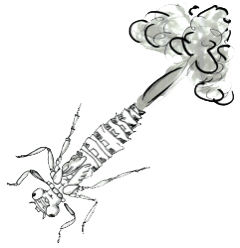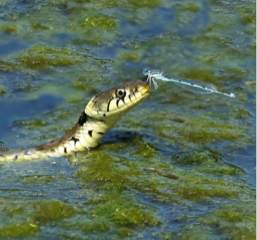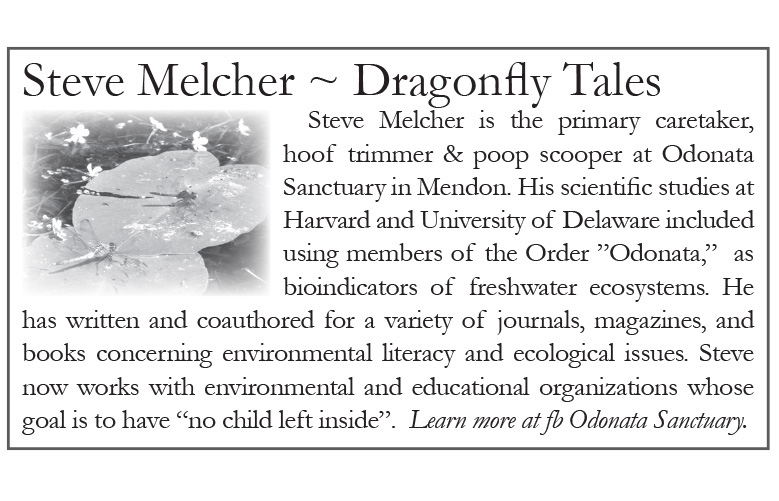Dragonfly Tales: There be dragons
by Steve Melcher –
“Magic is seeing wonder in nature’s every little thing, seeing how wonderful the fireflies are and how magical are the dragonflies.” ~Ama H.Vanniarachchy
“Watch out for his stinger!” “That one will sew your mouth shut…and your eyes…and your ears!” shouted Aunt Hazel agreeing with her younger  sister. My two aunts and I were walking along the swollen banks of the Susquehanna River years ago when I was young and impressionable. “What is that thing?’, I asked, grabbing Aunt Menzi’s hand while dodging away from what looked like a giant wasp or flying bright green toothbrush. ‘What – your mother never told you?, that’s the Devil’s Darning Needle’, whispered Aunt Hazel who always wore her hair swirled out from her head like the hat on the Flying Nun. Aunt Menzi shook her head with great gravitas in agreement. ‘Yes, that’s the Devil’s Dragon, a Snake Doctor, always found near water… and snakes…that one will lay an egg in your ear and the young will work it’s way to the other ear, eating through your brain on the way. Yep, at six years old, I was sufficiently shaken and wouldn’t have the nerve to go to the river’s edge for a number of years hence.
sister. My two aunts and I were walking along the swollen banks of the Susquehanna River years ago when I was young and impressionable. “What is that thing?’, I asked, grabbing Aunt Menzi’s hand while dodging away from what looked like a giant wasp or flying bright green toothbrush. ‘What – your mother never told you?, that’s the Devil’s Darning Needle’, whispered Aunt Hazel who always wore her hair swirled out from her head like the hat on the Flying Nun. Aunt Menzi shook her head with great gravitas in agreement. ‘Yes, that’s the Devil’s Dragon, a Snake Doctor, always found near water… and snakes…that one will lay an egg in your ear and the young will work it’s way to the other ear, eating through your brain on the way. Yep, at six years old, I was sufficiently shaken and wouldn’t have the nerve to go to the river’s edge for a number of years hence.
Apologies to Aunt Hazel and Aunt Menzi for making up such a horrid but certainly possible story. There was the belief that “the ‘Devil’s Darning-Needle’ would ‘sew together the fingers or toes of a person who goes to sleep within its reach’, according to my 1899 book titled, Animal and Plant Lore. The critter would also ‘sew up the mouths of scolding women, saucy children, and profane men’. The message being, if you see one of these…snakes, water, scolding aunts, flying toothbrushes and imminent danger are nearby.
Folklore
 Devil’s Darning-Needle is, of course, a folk name for that spectacular and harmless denizen of waterways and wetlands: the dragonfly. The Dictionary of American Regional English (DARE) lists a slew of evil sounding epithets for dragonflies including Devil’s Tailor, or Darning Needle. If you hail from Wisconsin, you might call them Schneiders – the German word for tailor. This nomenclature was probably derived from the dragonfly’s back and forth hunting and territorial patterns, ‘stitching’ his way across the pond. In other parts of the country you may hear them referred to as ‘ear cutter, eye stitcher, snake doctor, horse stinger, mule killer and bee- butcher’. Yikes! Amazing the way parents used such fearful names to keep their progeny away from the dominion of dragonflies: running water, lakes, ponds, wetlands and other neighborhoods that may entice and trap the unwary child. The folklore of dragonflies would be a book in itself. The awe and fear assigned to them can be seen in the shield of the Samurai and the petroglyphs of our own southwest. An ancient order, we should be thankful that the dragonflies of the Carboniferous period aren’t around today. Meganeura is a genus of extinct dragonfly that had a 28 inch wingspan that could’ve carried off a small child or at least your little Shih Tzu.
Devil’s Darning-Needle is, of course, a folk name for that spectacular and harmless denizen of waterways and wetlands: the dragonfly. The Dictionary of American Regional English (DARE) lists a slew of evil sounding epithets for dragonflies including Devil’s Tailor, or Darning Needle. If you hail from Wisconsin, you might call them Schneiders – the German word for tailor. This nomenclature was probably derived from the dragonfly’s back and forth hunting and territorial patterns, ‘stitching’ his way across the pond. In other parts of the country you may hear them referred to as ‘ear cutter, eye stitcher, snake doctor, horse stinger, mule killer and bee- butcher’. Yikes! Amazing the way parents used such fearful names to keep their progeny away from the dominion of dragonflies: running water, lakes, ponds, wetlands and other neighborhoods that may entice and trap the unwary child. The folklore of dragonflies would be a book in itself. The awe and fear assigned to them can be seen in the shield of the Samurai and the petroglyphs of our own southwest. An ancient order, we should be thankful that the dragonflies of the Carboniferous period aren’t around today. Meganeura is a genus of extinct dragonfly that had a 28 inch wingspan that could’ve carried off a small child or at least your little Shih Tzu.
But the truth is, dragonflies are harmless, even helpful if you consider the number of mosquitoes they consume. Dragonflies are an important factor in the control of the mosquito population and insect population in general. A single dragonfly can eat 30 to hundreds of mosquitoes per day. And they are very proficient hunters. In one study we did at Wood Hole Oceanographic Institute, dragonflies caught 90 to 95 percent of the prey released into their enclosure. And they are fast buggers, travelling up to 30 mph. What would that be in human terms? They can also hover, turn on a dime, fly backwards, even mate in mid air. In fact, they only catch their prey in flight.
Why Odonata Sanctuary
 Dragonflies are voracious predators. Their scientific name, Odonata, means flying tooth or toothed wing in Greek. Odonata is also the name given to our sanctuary in honor of my area of research for the past 30 years. The name seemed to fit in with other names in upstate New York. Odonata sounds like many place names given to us by earlier dwellers of the land. Oneida, meaning the People of the Upright Stone, or standing stone, could represent the lone dragonfly perched on a rock in a bubbling stream. O:na:ta is the ‘corn spirit’, o:ne:ka is the Seneca word for water, and Ondatra, another wetland resident, is the Iroquoian as well as scientific name for the muskrat. Or Odonata could simply be interpreted as ‘O’ de Nada’, ‘song to nothing’ or something else entirely to fans of the hero called ‘Nada’ in the movie ‘They Live’.
Dragonflies are voracious predators. Their scientific name, Odonata, means flying tooth or toothed wing in Greek. Odonata is also the name given to our sanctuary in honor of my area of research for the past 30 years. The name seemed to fit in with other names in upstate New York. Odonata sounds like many place names given to us by earlier dwellers of the land. Oneida, meaning the People of the Upright Stone, or standing stone, could represent the lone dragonfly perched on a rock in a bubbling stream. O:na:ta is the ‘corn spirit’, o:ne:ka is the Seneca word for water, and Ondatra, another wetland resident, is the Iroquoian as well as scientific name for the muskrat. Or Odonata could simply be interpreted as ‘O’ de Nada’, ‘song to nothing’ or something else entirely to fans of the hero called ‘Nada’ in the movie ‘They Live’.
Dragonflies may have been given horrendous names of warning by parents in the past, but the names given to them by Odonatophiles (lovers of all things involving dragonflies as opposed to (careful) ‘Odontophilia’ – a sexual fetish that involves teeth), have many wonderful names for their object of affection. One of my favorites is ‘Prince Baskettail’, other favorites are the Moustached Darter and the Fragile Forktail.
The Order Odonata includes dragonflies as well as damselflies. There is an interesting contrast between dragons and damsels. They are closely related genetically but the damselflies haven’t carried the baggage or specter of being a warning sign like the dragons. The Damselflies, are typically smaller and more elusive than their dragon cousins. The delicate damsels are given names like Beautiful Demoiselle, and Willow Emerald Damselfly. One easy rule of thumb to tell them apart is to watch them land. Dragonflies hold their wings horizontally while damsels raise them vertically behind their backs when at rest.
Bioindicators
I was first scientifically introduced to dragonflies through my studies in freshwater ecology. Dragonflies spend part of their life cycle underwater in the form of a larva or nymph (sometimes called a naiad). I was working under a Metropolitan Edison grant to determine the effects of the cooling water from the Three Mile Island Nuclear Power Plant on the aquatic life of the Susquehanna River. There were chemists, and fish experts, hydrologists and entomologists on the team. I was thrown in the group of bug experts and was soon introduced to the world of benthic macroinvertebrates. Benthic simply means ‘bottom dwelling’ and macro (large) and invertebrates (without a backbone). Many of these benthic macroinvertebrates turned out to be dragonfly nymphs, which because we lacked keys or ways to identify them at that time, we had to raise
to adulthood for identification. I was adept at raising the little nymphs to adulthood and became the one responsible for ‘hatching dragons’. The dragonfly nymphs are fascinating creatures. I’m sure who ever thought up the creature in the movie ‘Alien’ procured many of ideas from pictures of dragonfly nymphs. Some species have a ‘jagged toothed spoon’ under the jaw that can be whipped out to seize prey with lightning speed and bring it back to an awaiting open mouth. Being underwater they have to use gills to draw oxygen from the water. The gills of some species are actually located in their rectum. They breathe by drawing water in and out through their anus. That same species can shoot away from predators by drawing in water and quickly ejecting out the anus, moving quickly through the water in a form of jet propulsion…giving new meaning to the saying, “Blow it out your arse’. In this larval stage, which can last up to two years, the nymphs will eat just about anything their own size and larger including tadpoles, mosquitoes, fish, other insect larvae and even each other. I wonder how big the nymph of the extinct Meganeura was! That creature would’ve kept kids away from murky swimming holes.
Benthic macroinvertebrates (BMI) turn out to be excellent bioindicators of the health or the environment. We were able to determine many parameters such as water temperature and dissolved oxygen levels by the species that were collected from a particular site. We would use nets and dredges to collect the critters, count them in sieves, pickle some and return the rest. Meanwhile our boatmates would be using thousands of dollars worth of equipment to determine the same critical parameters. Needless to say, since we were determining the same information using far fewer funds, our methods were soon to become the standard for ecological studies involving the health of waterways. I did develop a device to collect benthic macroinvertebrates that is still in use today. The inexpensive device could be placed in the water and then later collected. The BMI move into the device and set up housekeeping on the substrate acting somewhat like a roach hotel. The light weight tool can then be collected, taken apart and the BMIs identified. The general health of the waterway can be determined by the number and type of organisms collected. I called it the ‘A.S.S.’ or Artificial Substrate Sampler. Marketed to scientists as well as fly fishermen, the sales pitch was ‘You don’t have to get your ass wet to collect mayflies’.
Citizen Science
Odonata Sanctuary was a major contributor to the New York State Dragonfly Survey carried out between 2004 and 2009. Through the work of many volunteers, most of the 26 species found, photographed and identified in Monroe County were from Odonata Sanctuary. We expected to find 50+ species, so there is still work to be done! Its April in upstate New York and migration season is in full swing, but it isn’t just the birds that are migrating. As part of a program called ‘Journey North’, Odonata Sanctuary’s ‘Mariposa de Mendon’ team helps track the migration of hummingbirds and monarch butterflies. We know that the annual migration of the monarch butterfly is multigenerational and complex, but the record for the longest insect migration is held by a dragonfly. The Wandering Glider migrates almost twice the distance of the monarch travelling a whopping distance of 4,400 miles or more. Although conjectured for over one hundred years, we unfortunately know very little about dragonfly migration. In North America we know that certain species are migratory but almost nothing is known about where they come from or where they are going. I remember tagging monarch butterflies at the University of Delaware with tiny mylar numbered markers back in the ‘70s. That research eventually led to the discovery of the monarch’s secret wintering grounds in the oyamel fir trees of Michoacan and other Mexico states. We need a similar concerted effort, to place tags on dragons, to determine the secrets of Rhaegal’s journeys.
Hopefully, you can now venture forth without the fear of having your lips sewn shut or being stung by a dragonfly. Many birders and photographers have turned their scopes and cameras toward the water’s edge in search of Odonates. There are many excellent books on identifying and photographing dragons and damsels. I encourage you to pause by that stream or pond a bit longer to observe and study the fascinating denizen of wetlands – the dragonfly.
Perhaps I’ll see you on one of our wonderful Finger Lakes in a birch bark canoe, paddling alongside a giant Green Darner.
